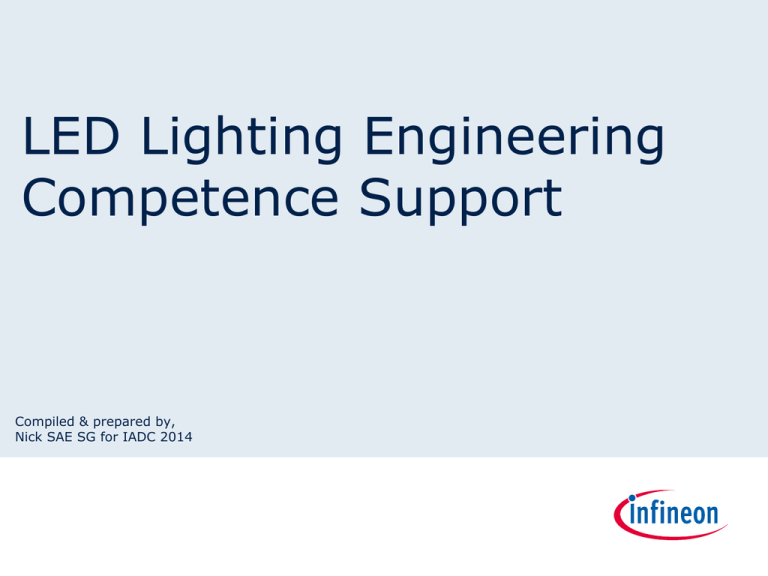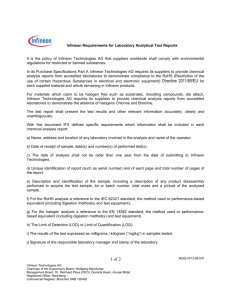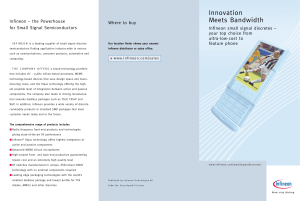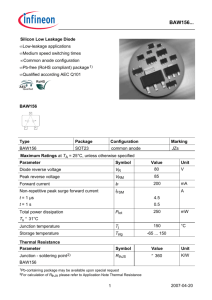
LED Lighting Engineering
Competence Support
Compiled & prepared by,
Nick SAE SG for IADC 2014
IFX LED Lighting Competence Support
Accelerating towards first-time right design for LED lighting electronics
Requirements and specifications gathering
set date
Selecting the right topology
Dimensioning components
Electrical simulation to validate design
Evaluate PCB thermal performance
Evaluation
Demo Board
App Board
Demonstrator
Simulation
Pspice Simulation
Thermal Simulation
Design
App Note: Theory & Design Guide
Quick Excel Calculator
Easy-Ape
Quick hardware guides
in EMC improvement
LED Lighting Competence Support Package
Start
Copyright © Infineon Technologies AG 2013. All rights reserved.
Quick evaluation with easy
component adaptation
to ready-to-use board
End
Page 2
Design App Note for TLD509x DCDC Multitopology Controller
From theory to practice
Comprehensive 10-steps design guide to
components selection and dimensioning
set date
Copyright © Infineon Technologies AG 2013. All rights reserved.
Page 3
Design App Note for Basic LED drivers and
LIN LED Drivers
Request for availability
set date
Copyright © Infineon Technologies AG 2013. All rights reserved.
Page 4
Quick Excel Design Calculator
Output calculated ideal
components dimensioning
Generate
set date
Copyright © Infineon Technologies AG 2013. All rights reserved.
Page 5
Pspice simulation for design verification
Pspice models for Infineon products –
Power LED Controller and *Basic LEDs
Drivers are AVAILABLE ONLINE.
Website: http://www.infineon.com/cms/en/product/power/led-driver-ic-and-lighting-ic/auto-led-driver/power-leddriver/channel.html?channel=db3a30432239cccd0122efd10ba721ed&tab=2
*For new release product, please request the Pspice models from your respective FAE.
set date
Copyright © Infineon Technologies AG 2013. All rights reserved.
Page 6
Benefitting from Thermal
Simulation
Infineon Thermal Tools and Capabilities (1)
Thermal Device (Package) FE-Simulation
o Steady-state thermal simulation
o Transient thermal simulation
Used for
o New package design evaluation
o On Customer board assessment
o Package thermal performance optimization
Thermal System Simulation with FloTHERM
o Steady-state thermal simulation
o Limited transient thermal simulation
Used for
o Board and system temperature profile evaluation.
130°C
o Customer requirement support and consultation.
set date
Copyright © Infineon Technologies AG 2013. All rights reserved.
Page 8
Infineon Thermal Tools and Capabilities (2)
PCB Flotherm Thermal Simulation
o Steady-state thermal simulation ONLY
Used for
o PCB board thermal performance optimization
TLD1120 Thermal
Model
Device No. Pdiss(W)
U1
1.06
U2
1.07
U3
1.08
U4
1.09
U5
0.55
U6
0.25
Condition:
Ambient Temperature = 85degC
Environment: Still Air
FR4, 4 layers -> 2S2P, Cu 2oz (top/bottom), Cu 0.5oz(mid)
Copper 2oz
Heatsink
set date
Copyright © Infineon Technologies AG 2013. All rights reserved.
Page 9
Infineon Thermal Tools and Capabilities (3)
Transient Thermal Multisource Simulator TTM
Linear Response Theory:
Once the unit power step response (Zth-curve) is
known, we can compute the temperature for any
power profile P(t) implemented in TTM.
t
T (t ) P( ) Z th (t ) d
0
Use Detailed Component Models When Possible
Problem:
Block Model not accurate enough to correctly
simulate device junction temperature!
Solution:
Use detailed device models when possible!
We can provide FloTHERM models for
Infineon products.
IFX
IFX
Summary
PCB thermal performance is very critical in LED lighting – usually
dictates the amount of heatsink required and lifetime of products
Information on the Rthja in datasheet may not be applicable in most
applications due to thermal coupling from adjacent heat sources and
difference in board size and cooling areas implemented.
Thermal simulation enables first time RIGHT designs in LED lighting in
pcb board development
IFX is able to provide detailed IFX LED drivers thermal models to
customers for more accurate junction temperature prediction
Set date
Copyright © Infineon Technologies 2011. All rights reserved.
Page 12
Improving the EM emission
through hardware
modifications
EMC Standards
IEC 6100 - x - x
EN 550xx (CISPRxx)
radiated immunity
conducted immunity
radiated emission
Device
conducted emission
Critical for switching
Power supply
2013-03-05
for internal use
Copyright © Infineon Technologies AG 2013. All rights reserved.
- DRAFT -
Page 14
What does Class I to Class V mean?
Class I to Class V are test severities
Class V: lowest noise emission test limits
Class I: highest noise emission test limits
The end user (OEM) determines which test level he needs
Depending on the usage and location of the application
Module near the radio low noise emissions needed (Class V)
The Tier1 usually requires Class V
Sometimes the same controller for different vehicles and different
locations will be developed, so the highest test level is necessary.
2013-03-05
for internal use
Copyright © Infineon Technologies AG 2013. All rights reserved.
- DRAFT -
Page 15
Challenges in EME
Fulfill the CISPR25 Class V limits for the entire application
(Application board, wiring, load)
Class I: Highest level noise emission
test limits
Why Class V required ?
Class V: Lowest level noise emission
test limits
2013-03-05
for internal use
Copyright © Infineon Technologies AG 2013. All rights reserved.
• Module near radio
• Requirement for most Tier 1
• Similar controller developed
@ different vehicle location
- DRAFT -
Page 16
Exploring hardware opportunities to improve
Electromagnetic Emission: CISPR-25
Guide for improvement in EME
Input Filter:
22µH + 10µF
Output Filter:
10µH + 470pF
Gate Resistor:
39Ω
Snubber Network: 2Ω + 680pF
Commutation Capacitor:
set date
Copyright © Infineon Technologies AG 2013. All rights reserved.
1µF
Page 17
EME evaluation: With and without external
filter performance
Without Input/Output filter
Class I
Class V
With snubber network,gate resistance,
output filter
set date
Copyright © Infineon Technologies AG 2013. All rights reserved.
Page 18
Layout Opportunities to EME improvement
PCB layout reference
and guide to reduce
EME
set date
Copyright © Infineon Technologies AG 2013. All rights reserved.
Page 19
Layout Opportunities to EME improvement (In
summary)
1
Keep the inductance of the commutation loop as small as possible.
2
Reduced area with high dv/dt
Parts with high dv/dt will cause radiated emission.
3
Page 20
Place a solid GND plane below active parts
April 14th 2011
EMC Test Report
set date
Copyright © Infineon Technologies AG 2013. All rights reserved.
Page 21
Summary
Class V EME based on CISPR-25 is desired
Improvement of EME can be done through step-by-step guides by
adding external filters
Layout is equally important in EME
EMC test report can be provided upon request to customer
Set date
Copyright © Infineon Technologies 2011. All rights reserved.
Page 22
Demoboards and Appboard
Quickstart Evaluation Board Available
Demoboards are designed for lab measurements including connectors
Demoboard for TLD509x family
Demoboard for Basic LED family
AppBoard for TLD509x family ( SEPIC, B2G, B2B)
Appboard are application
optimized with smallest possible
size.
set date
Copyright © Infineon Technologies AG 2013. All rights reserved.
Page 24
IFX LED Lighting Competence Support
LED Lighting Competence Support Package
Simulation
Pspice Simulation (online)
Thermal Simulation**
Evaluation
Demo Board **
App Board **
Design
App Note: Theory & Design Guide (online)
Quick Excel Calculator **
Easy-Ape **
Quick hardware guides **
in EMC improvement
EMC guides and report **
** Available upon request
set date
Copyright © Infineon Technologies AG 2013. All rights reserved.
Page 25
set date
Copyright © Infineon Technologies AG 2013. All rights reserved.
Page 26




